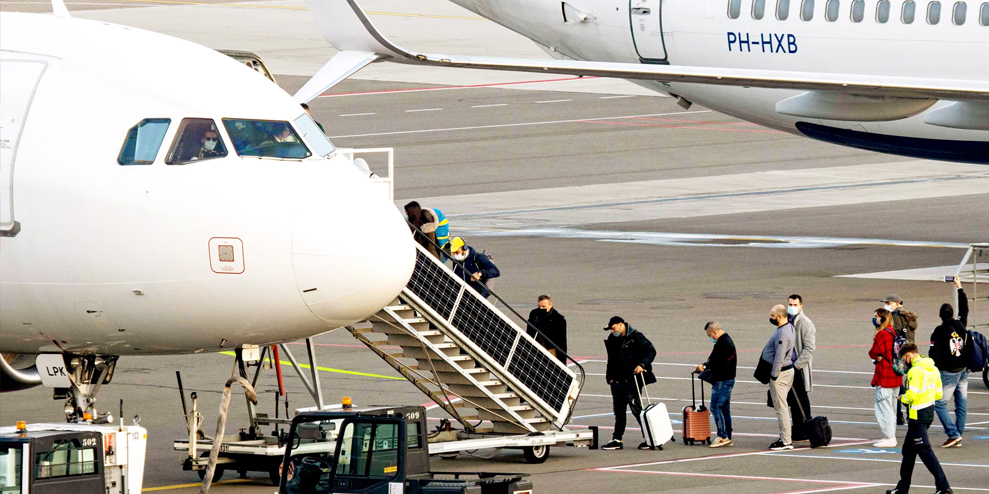JASON STEFFEN STUDIES planets in other solar systems. His most famous work—OK, second-most famous work—was with NASA’s Kepler Mission, a survey of planetary systems. But you’re more likely to have heard of Steffen, a professor at the University of Nevada at Las Vegas, in a very different context: as a student of the airplane boarding process. Years ago, after waiting in yet another line on a jam-packed jetway, the physicist thought to himself, “There has to be a better way than this.”
Airlines are invested in boarding times—and to a lesser extent, offboarding—because time equals money. Flying people around the world is a low-margin business, and the faster you can get a flight loaded, into the air, and then emptied on the ground, the faster you can get the next round of paying customers into the air.
In 2008, Steffen published a paper detailing his way, which has become known as the Steffen method. Forget the point-counters in business class. Forget the smug airline-branded credit card wielders with priority boarding. Forget even the first -class passengers—the complimentary champagne can wait. The fastest way to board an airplane, he concluded, is to allow many people to do many boarding tasks at once. Start with the person in the window seat in the last row on the right side. The person in the third-to-last window seat goes next, allowing time to swing items into the overhead bin. Then the person in the fifth-to-last window seat, and so on until the right side fills up. Then the left side. Then the same pattern for middle seats. Then the aisle. Yeah, a little complicated.
It’s been over a decade, and maybe it won’t surprise you to learn that no airlines have fully gone for the Steffen method. In fact, there’s a subgenre of global researchers—engineers, physicists, computer scientists, cyberneticists, and economists—who search for more optimal ways to cram crowds onto flying metal tubes. They’ve devised at least 20 methods to get people onto planes. But for many reasons—airline finances, airport infrastructure, technological shortcomings—their research has mostly fallen on deaf ears. In 2013, the Dutch airline KLM experimented with a modified Steffen method boarding process, but the company later said the trial had no “tangible additional benefit.”
Now a global pandemic has done the seemingly impossible: shaken up airplane boarding procedures. Along with requiring masks, providing hand sanitizer, and, in some cases, banning passengers from middle seats, many airlines have created boarding and deboarding processes that try to avoid packing flyers too closely together.
Delta, which previously boarded passengers according to ticket classes and mileage club memberships, is loading the airplane back to front, so that flyers don’t pass by others as they make their way to their seats. After preboarding families and passengers that need extra time, United is going back-to-front too. Even Southwest, famous for letting passengers choose their seats, is only letting 10 passengers on at a time, instead of the usual 30. The process is certainly slower, but Southwest, and other airlines, have far fewer passengers these days.
Researchers pushing for smarter approaches to getting on airplanes are hoping for more change. Big changes in aviation tend to only happen when people die or get hurt, says Michael Schultz, who studies air transportation at Technische Universität Dresden. The airlines “try to learn what’s going wrong, and then they try to improve,” he says.
With that in mind, Schultz has been working since last spring with colleagues around the world to identify and simulate the fastest—and safest—way to get people onto and off airplanes right now. He hopes the pandemic pushes airlines to update their technology, so that they’re able to board passengers dynamically, pushing an alert to a passenger’s smartphone when it is their turn to board. He thinks a connected aircraft cabin filled with sensors could help crews direct flyers through often-hectic deboardings too.
“Airlines are dealing with a very precious balancing act,” says Martin Rottler, an aviation veteran who now runs his own consultancy. “They need to balance efficiency with customer satisfaction, and now they need to add on safety.”
Another team of researchers, divided between Bucharest, Romania and Potsdam, New York, think they’ve hacked the perfect mix. They call it the “WilMA back-to-front offset-2,” and it boards back to front, by rows, with the window seats first. The method might occasionally see a passenger on her way back briefly pass someone already sitting at the window. But it threads the needle, the researchers say, between safety and efficiency.
In fact, the boarding process is a little like what lots of airlines are doing now. “They’re just not quite fine-tuning the method” to make it even easier, says John Milne, an engineering management professor at Clarkson University who worked on the research. It’s high time, in other words, for the academic plane-boarding obsessives, not the business people, to be in charge for a change.

